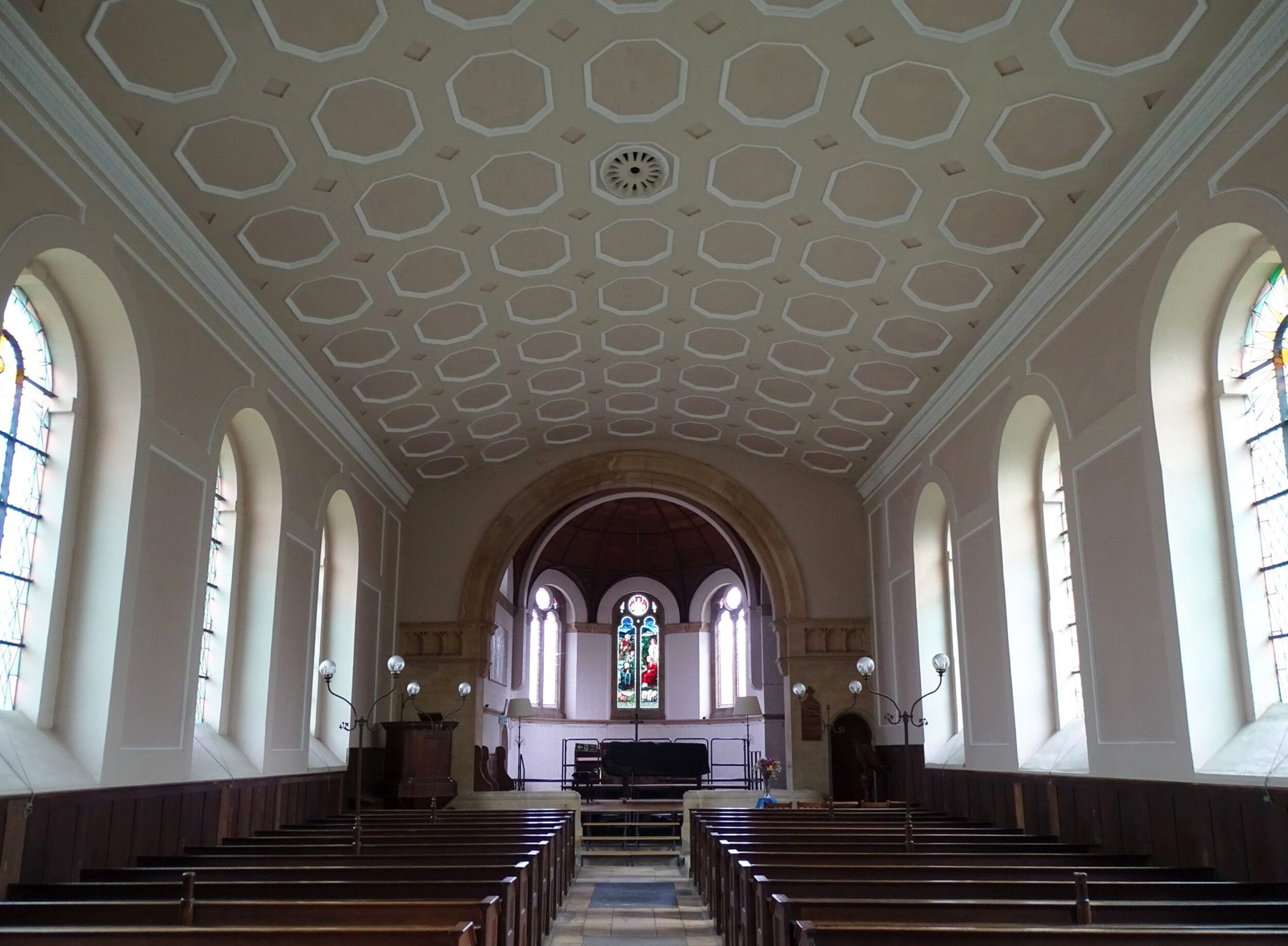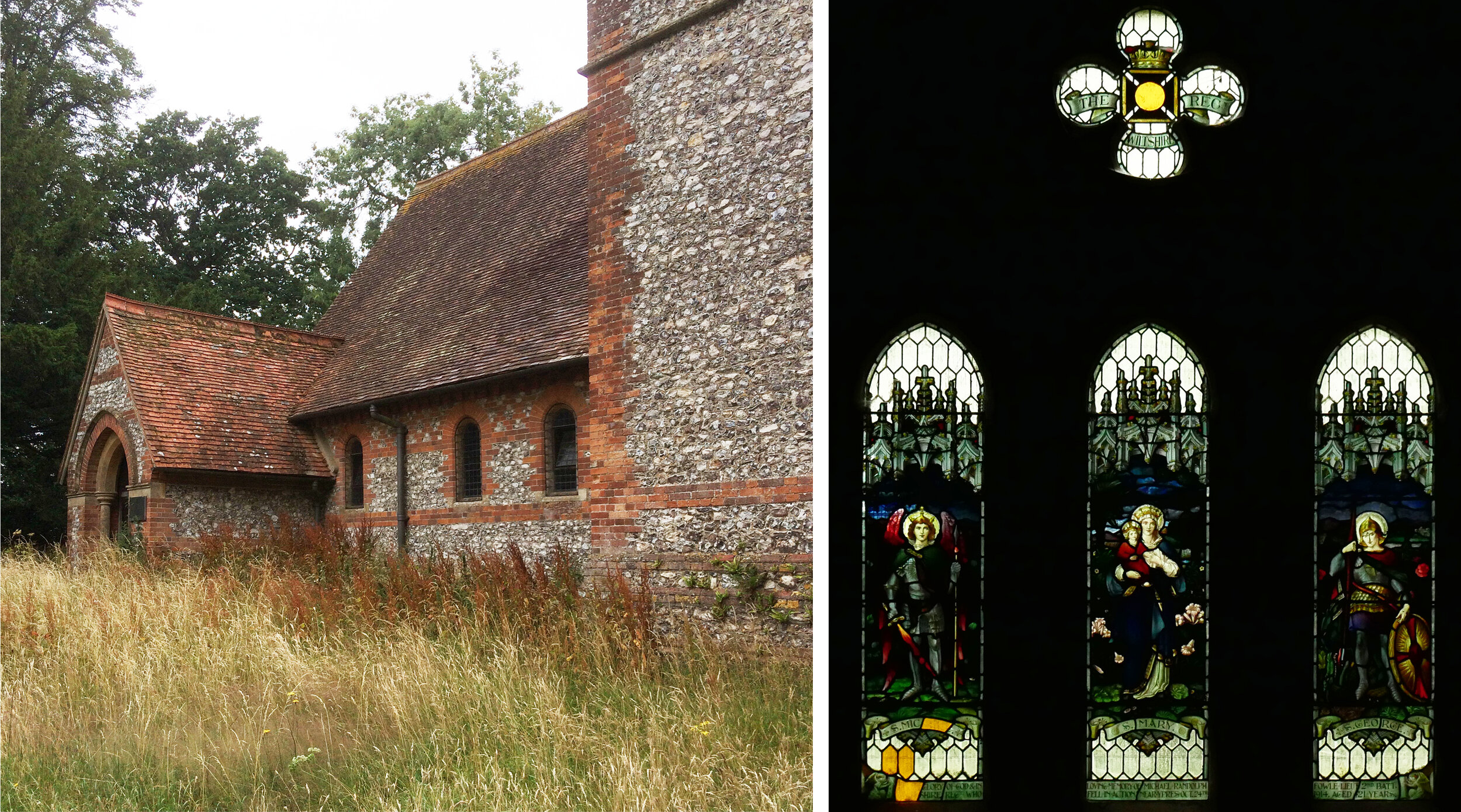St Mary’s Church, Whaddon, Witshire. Left: Entrance porch. Right: Inside, facing east.
Here we are in Whaddon Church on a stormy day beside the River Avon in Wiltshire (above). The church is down a windy dead end road - I’d seen the Harry Stammers window there only from the outside because it was, as churches so frequently are, locked. This time, I made an appointment and took along some friends to chat with the key holder and take photos of me taking photos of the window that we all admired so much (below).
Whaddon: Window by Harry Stammers 1950.
The subject matter is from Matthew chapter 13 verses 24 & 25: ‘The kingdom of heaven is like a man who sowed good seed in his field. But while everyone was sleeping, his enemy came & sowed weeds among the wheat, and went away’. In the window the good sower and his enemy have the same posture and are placed on similar backgrounds but with dramatically different colour combinations that emphasise the contrast of day and night, light and dark. There are areas of loose brushwork that contrast with sharply painted plants and the familiar Stammers style cartouches for the lettering (below). The window is dedicated to the memory of George Merrett a local lay preacher who walked across the fields every Sunday, on the day we were there the fields were flooded and the windy road almost impassable.
Detail of the Whaddon window with Harry Stammer’s mark.
In Holt, only a mile across the river but quite a long way round by road, is another Harry Stammers window. Again I’d made an appointment and again the key holder was surprised that we were more interested in the Stammers window than the other ones - in both churches they are by Horwood from about 1880. This is an early Stammers work, with the figures and cartouches suspended on a standard background of white glass quarries and no maker’s mark to be seen. There are few indications here of how his later style would develop, and had already started developing by the time he was commissioned to make the Whaddon window four years later.
United Reformed Church, Holt, Wiltshire. Window by Harry Stammers in the south aisle 1946.
The Holt window is dedicated to St Cecilia, and in memory of another much loved local character, Daisy M. Tucker, who was choirmistress and also organiser of the local sewing bee - hence the bees (below left) or so the much repeated story goes.
Details from the Holt window.
St Mary, Wilton, Wiltshire. Harry Stammers window 1952 and detail with his mark.
The other Stammers window I know of in Wiltshire is in St Mary’s Church in Wilton (near Salisbury) and now in the care of The Churches Conservation Trust. In this window, although St Edith and St Monica are also floating on those clear background quarries, the composition fills more of the space and the style of the figures, particularly in the sections below them, is veering away from the naturalistic. Here is the same contrast between light and dark and the monochrome figures that you find in the Whaddon window and that he used so much in his later work.
Wilton. Left: St Monica. Right: scene below with monochrome figures.
St Peter’s Church, Over Wallop, Hampshire. Left: Detail of St Michael in left hand panel. Right: Window by Harry Stammers 1956, on the wall is the flag of The Glider Pilot Regiment.
Four years later Stammers made a window for St Peter’s Church in Over Wallop, just over the Wiltshire border into Hampshire. It tells the sad story of three members of the same family, Joan Mary Grece, Group Captain C.M.M. Grece and her uncle H.D. Harman who were killed in a flying accident in 1954. The picture of the plane (below) gives this window a 1950s ‘Festival of Britain’ feel, and like much of his work from this period the window design is crisp and graphic.
I’ve always wondered if the practice of using white glass backgrounds that was so common in this period of stained glass and that lets in too much light was done for cost cutting reasons. I say this because that was why I started using so much clear glass myself, especially when I was a student. The Whaddon window, so small and so satisfying in its all over composition, rather reinforces my suspicions.
Detail of the Over Wallop window.




















